Intestinal worms or other worms in humans are an invasion that affects the whole body. This disease is caused by infection by the eggs and larvae of worms and is characterized by a range of specific symptoms.
The diagnosis is made with several tests, both in the feces and in the blood. Worms on the abdomen and other organs appear in adults and children, may appear in the anus, in the stool or do not appear in any way.
Causes
Intestinal worms are transmitted mainly by fecal-oral route, ie for infection, the eggs of parasites or worm larvae must be swallowed. An unpleasant feature of this invasion is that some species of helminths in children and adults remain stable for a long time outside the host's body (for example, in water, on land).
Adult-laying parasite eggs remain capable of becoming infected for several months. This feature leads to the fact that some types of worms in children and adults are very common.
The main routes of infection are as follows:
- Infection through the use of untreated water, which can be in a well, a natural reservoir, or even leaking from the tap. Almost all intestinal parasites in humans survive and multiply in water for a long time, so it is better to drink bottled water. In areas unfavorable to sanitary conditions, well water can be used only after prolonged boiling;
- The appearance of a worm on a baby's butt can occur as a result of eating a poorly washed vegetable. If fertilizer is used to fertilize the soil, which was infected with worms, then the larvae, eggs and their adults appear and survive for a long time in the soil. Along with soil particles, eggs fall on vegetables. If such a vegetable is poorly washed, then they will enter the host's body, provoking helminthic invasion in a person;
- Swelling and other characteristic symptoms of infection can occur after eating contaminated meat, fish or poultry. If an animal, bird or fish has suffered from helminthic infection during its lifetime, then it is very likely that its flesh is also infected, while parasites (for example, fish) take root easily in the human body. You can get rid of them only as a result of careful and prolonged treatment of the meat heat (cooking or frying at maximum temperatures). You can also defeat the invasion by freezing. But since most modern home freezers are able to provide a maximum temperature of about 8 degrees, it is necessary to keep meat, fish or poultry there for at least a week;
- Signs of worm infection in humans can appear after contact with a pet. Dogs and cats walking on the street almost always have stomach worms (domestic cats, usually, are not infected). During hygienic procedures, the animal spreads the worm eggs from the anus to the entire layer. If you kiss such an animal or do not wash your hands after contact with it, you can get worms in the human body, as animal invasions take root and multiply in the human body;
- A person may notice bloating and other signs of the presence of helminths even after swimming in an infected pond. This is a fairly rare method, but infection is possible;
- Transmission of helminthiasis to humans from one individual to another occurs through surfaces, towels, linen. Eggs and larvae move to surfaces or tissues from the skin of an infected person and from there migrate to the skin of a healthy person when touched. After that, there is the possibility of their introduction into the oral cavity of a healthy person and the development of infection.
It is worth remembering that many types of intestinal parasites are common in groups of children. This is because many children do not worry too much about hygiene and many areas in kindergartens are covered with poisonous eggs, the picture of which is shown below, even if only one child was initially ill.
For this reason, the main task of parents is to explain to the baby that all types of worms in humans are dangerous and can persist in the skin of the hands and get into the mouth from it. For this reason, good hygiene is important. A video about the spread of worms in women, men and children and the features of their development is posted at the end of the material.
varieties
Some patients are interested in what color are the worms and how to visually determine what they are in the stool? Most often these are white or light worms, although sometimes transparent worms are also found in humans. They are flat or round, sometimes having two dark food channels on the sides.
- The largest human worms are called tapeworms. The largest in this group is the bull worm. According to scientific research, they can live in the intestine up to 40 years and reach several meters in length.
- Roundworms are the most common type of pest, which belongs to the roundworm nematodes. Could such individuals be very large? Females reach a length of about 25 cm, males - 12 cm;
- Breastworms are more common in children than in adults. These are small individuals, similar in description to roundworms, but smaller. The largest worm barely reaches 10-12 cm;
- Giardia is the smallest type of parasite. It is quite common. If found in feces, you need to think about what to do with the worms and start choosing a treatment;
- Trichinosis invasions are characterized by the most severe course, fever and facial edema are present. Such invasions are called those caused by Trichinella nematodes.
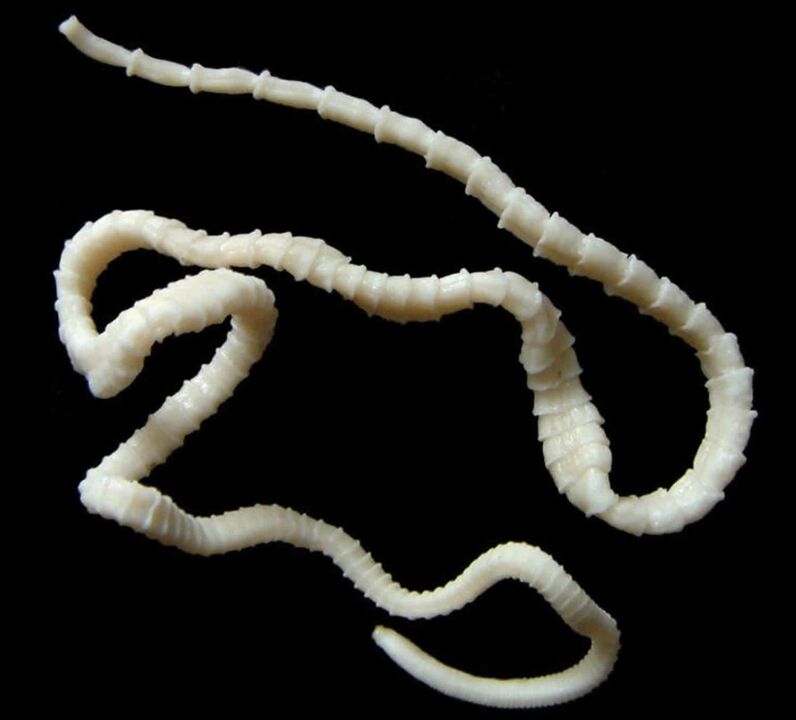
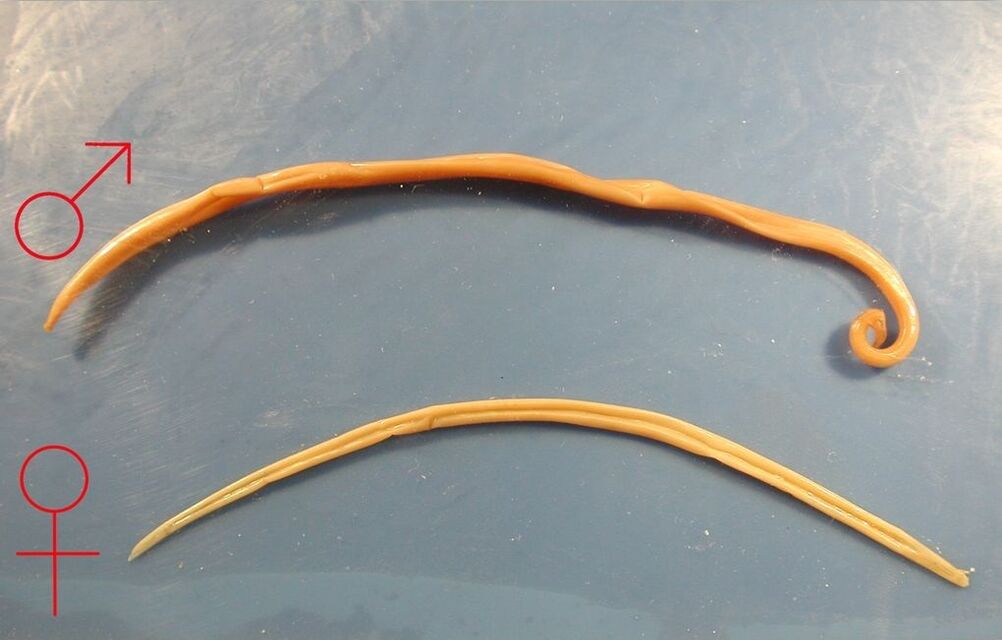
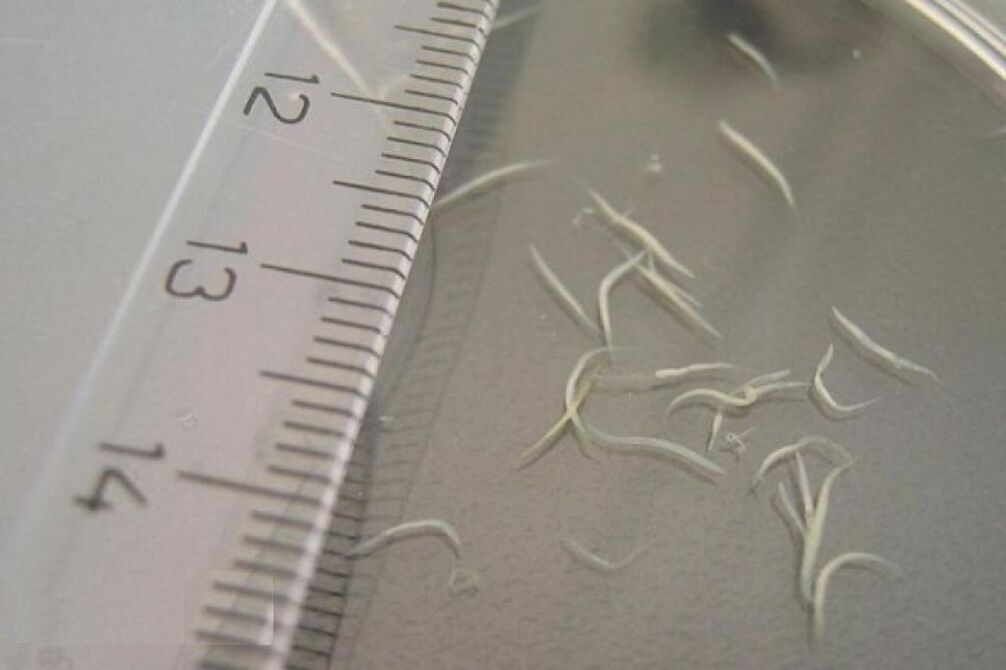
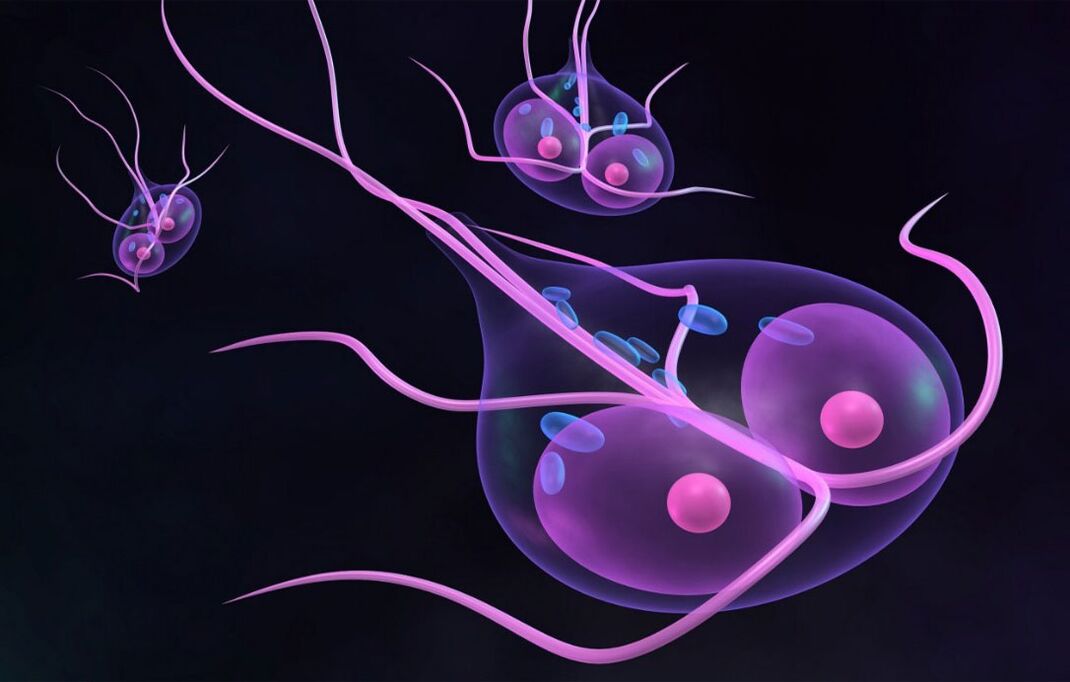
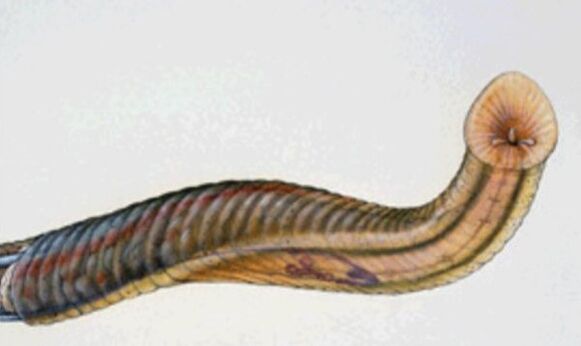
The most common types of individuals have common features and are visible in the feces. Therefore, the feces of a person with worms can be distinguished from the feces of someone who is not infected.
Localization
Some people who suspect they have an invasion are interested in where in the human body the worms are located? Although it is traditionally believed that worms occur in the human body in the intestines, this is not entirely true.
Almost all types of helminths in humans can develop in many organs and systems, which is associated with the peculiarities of their migration, when the larvae hatching from eggs in the intestine enter the bloodstream and spread with it throughout the body.
They enter the human body through the mouth, but their manifestation can occur in the following places:
- Subcutaneous parasites are not a very common type of tropical parasite carried by insects (Tsetse flies, specific tropical mites, etc. ). Parasites under the skin are almost never found in the middle lane, but there is a risk of infection with them on a tour. Such parasites are localized under the skin only in the initial stages of their life cycle, after which they can move to the muscles;
- A common place where localization is observed in women is the vagina, uterus. They can crawl there from the anus or infect the reproductive system in the migration phase;
- Worms in the ears of a baby or an adult are also found because the larvae often infect the organs of the ORL (including the throat);
- Many worms choose the digestive system and intestines as their site of localization. There they have enough food (blood and serum) and oxygen to maintain normal life. Treating intestinal parasites is usually easier than others. But even if they were originally in a person's stomach, then over time they can infect other organs;
- Signs of worms in the lungs can be confused with the characteristic symptoms of pleurisy or pneumonia. However, this is a common site of worm localization, so it is important to diagnose their presence in time;
- If the parasites injure the brain, then the nervous system is damaged. It can appear as convulsions, nervousness, unreasonable anxiety, etc. ;
- If worms in humans manifest in the heart, then tachycardia, rhythm disturbances and more are possible. In particularly severe cases, heart failure develops;
- In the liver, helminths are also common, as there they are mainly taken from the intestines through the portal vein.
As can be seen from the above, patients who wonder where worms live in humans should consider not only the type of invasion but also the stage of the infection.
Complications
It is important to know what worms lead to and what will happen if you do not treat them? Worms cause general intoxication of the body, which can be very pronounced.
Symptoms of an allergic nature also appear, as the immune system produces histamine to protect itself from foreign invasion. In this case, you need to remember what an allergic rash looks like with helminths - these are medium pink spots, sometimes hives, itching, usually, absent.
As with hepatic localization, and when located in other organs, a tapeworm in humans or another parasite causes damage to the mucosa and local inflammatory processes of a small area.
As a result, an abscess may occur (in the case of the liver, with a penetration of pus into the abdominal cavity and blood poisoning if left untreated).
As with damage to the bronchi and lungs, a cough often appears. Then bronchitis, pleurisy or pneumonia develop, which must be treated with antibiotics, despite the fact that this is a reaction to the invasion.
With the localization of parasites in the vagina, exacerbations of chronic diseases and disorders of the microflora may appear. It is believed that such a phenomenon can lead to infertility.
Symptoms
The symptoms of worms in humans are different, but they are characteristic of almost all types of parasites. However, chronic and acute infections can have different symptoms in adults. In acute infection, the following symptoms of the disease are characteristic:
- Elevated temperature in general normal condition (up to 38 degrees);
- Chills and fever-like skin symptoms (rash);
- When the larvae are localized in the lungs or bronchi, the symptoms in the body are expressed by cough;
- Inflammatory processes are signs of the presence of worms in the human body, therefore, an increase occurs in the lymph nodes;
- Worms and allergies in an individual are associated, therefore, signs of the appearance of worms in a person in the form of rashes and allergic reactions are possible.
But most often the symptoms of the presence of worms in humans are intestinal, as it is most often localized parasite. These are symptoms of a worm infection in an individual, like p. sh.
- Stool disorders - constipation or diarrhea, sometimes with blood;
- The first symptoms of worms are loss of appetite, vomiting, aversion to certain types of foods, which eventually leads to weight loss;
- The first signs of worms in adults can also be bloating and bloating;
- Over time, abdominal and stomach pain develops, not depending on food intake, intermittently or constantly;
- With worms, a person develops symptoms of general intoxication - paleness, drowsiness, chronic fatigue, etc.
Skin parasites cause specific symptoms in adults and children. Signs of worms are numbness of the extremities, tingling in the skin, headache, dizziness, much less often - fever. In any case, the incubation period of worms in humans is quite long and can last from a few weeks to several months.
For this reason, the first signs of worms in a person may not appear soon. And since almost all symptoms in a person of the presence of worms can indicate other diseases, often if a person has worms, this becomes clear only when they enter the feces.
Diagnosing
Even knowing how worms appear, you may not notice their appearance. Some types of worms do not appear for a long time, and the diagnosis of worms in humans can not be performed at home. In laboratories, the following methods are used to help determine if there are worms, the symptoms and treatment of which are discussed in this article:
- General blood test. Worms can be in case there are deviations in it. It looks like severe anemia - a significant drop in iron and hemoglobin levels. Occurs as a result of the fact that worms in humans cause local bleeding, constantly damage the mucosa, as well as are parasites that feed directly on blood;
- If the worms are in the intestines, then their remains will be present in the feces. What signs of worms in an individual are visible in the feces? These are eggs, larvae, or even adults of parasites. Although, if you know what worms look like in humans, adults in the stool can be identified independently;
- Regardless of where the worms come from in humans and what kind of worms in humans (protozoa, roundworms, tapeworms) antibodies to them appear in the blood. This is due to the fact that once a person has worms, the immune system considers them as an alien invasion and tries to defend itself against it by producing antibodies. This method helps to determine which types of worms are present and which symptoms should be expected, as different antibodies are produced for each invasion.
The latter method of diagnosis is especially good because it allows you to learn about worms at an early stage, identify the types of worms and discover how to treat worms in humans.
Treatment
Some of those patients who are interested in what human worms look like and how they enter the body also want to know how to cure them in an individual. The official drug treatment regimen for worms in adults includes a single dose of an anthelmintic drug that acts throughout the body when a person has worms.
It is also desirable to repeat the course of treatment in adults 2 - 3 weeks after using the medication for the first time. It is necessary to poison small and large infections twice to completely get rid of the larvae.
Another treatment is suggested if the worms are in children. Because drugs are toxic, treatment in adults has a negative effect on the liver. For children, medications have been prescribed that can be taken in a short course (several times), which reduces the load on the liver.
Some of those who ask how to treat worms in an individual choose the popular methods of warfare, when worms in an adult or child are eliminated by natural means.
It is believed that a mixture of ground pumpkin seeds with honey in a one-to-one ratio is effective against worms if consumed daily in a tablespoon.
Effective treatment is performed using enemas from a garlic-milk solution. You can also be treated for intestinal worms by drinking a similar solution. In the presence of worms in a person, the symptoms will start to appear weaker after a week.
Prophylaxis
By knowing where worms come from, where worms come from, you can determine a list of rules that must be followed to protect yourself from worms to humans. In order not to ask the question "do I have worms", it is worth doing the following:
- Wash vegetables and fruits well;
- Boil or fry the meat well, you can also freeze it for a long time;
- Use only bottled or purified drinking water;
- Limit contact with pets and perform regular prevention of helminth infection;
- Wash your hands regularly, especially after you are in public places.
If an infection is suspected, it is recommended that the stool be examined regularly for the presence of helminths.



























